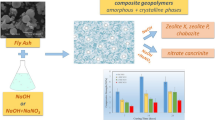The alkali activation of waste materials can produce a binder with similar properties as Portland cement but without the drawback linked to greenhouse gas emissions. Geopolymer pastes were made using coal fly ash as precursor and sodium hydroxide and solid sodium silicate powder as alkaline activators. One sample was activated with sodium silicate only while the second sample used a 50:50 mass% mixture of sodium silicate and 8 M NaOH solution. Fresh geopolymer paste was immediately placed in the Environmental SEM chamber for microstructure observation using the ESEM mode.
The sodium silicate activator dissolves rapidly and begins to bond fly ash particles. Open porosity can be observed and is rapidly filled with gel as soon as the liquid phase is able to reach the ash particle. The liquid phase is important as a fluid transport medium permitting the activator to reach and react with the fly ash particles. During this ESEM experiment, the reaction was limited to the surface of the fly ash particles. The reaction products examined had a gel like morphology and no crystallized phase was observed.
The effect of the activator on the gel composition was investigated by quantitative microanalysis. The gel analyzed in the sample activated with the mixture of sodium silicate and NaOH solution is enriched in Na and Al. In that sample, the fly ash reaction rate is more advanced considering that the gel is richer in Al and that this element results from the fly ash. In fly ash-based geopolymers, the aluminum content of the aluminosilicate gel is an indicator of the fly ash reactivity.







Similar content being viewed by others
References
Fernandez-Jimenez, A., Palomo, A., Criado, M.: Microstructure development of alkali-activated fly ash cement: a descriptive model. Cem. Concr. Res. 35, 1204–1209 (2005)
Malhotra, V.M.: Introduction: sustainable development and concrete technology. ACI Concr. Int. 24(7), 22 (2002)
Mehta, P.K.: Sustainability of the concrete industry—critical issues, ACI Strategic Development Committee’s “Concrete Summit on Sustainable Development”, Washington DC, 29 March 29 2007
Duxson, P., Fernandez-Jimenez, A., Provis, J.L., Lukey, G.C., Palomo, A., van Deventer, J.S.J.: Geopolymer technology: the current state of the art. J. Mater. Sci. 42, 2917–2933 (2007)
Hardjito, D., Wallah, S.E., Sumajouw, D.M.J., Rangan, B.V.: On the development of fly ash-based geopolymer concrete. ACI Mater. J. 101, 467–472 (2004)
Kovalchuk, G.Y., Fernandez-Jimenez, A., Palomo, A.: Alkali-activated fly ash: effect of thermal curing conditions on mechanical and microstructural development—Part II. Fuel 86, 315–322 (2007)
Palomo, A., Grutzeck, M.W., Blanco, M.T.: Alkali-activated fly ashes—a cement for the future. Cem. Concr. Res. 29, 1323–1329 (1999)
Davidovits, J.: Geopolymers inorganic polymeric new materials. J. Therm. Anal. 37, 1633–1656 (1991)
Bakharev, T.: Geopolymeric materials prepared using Class F fly ash and elevated temperature curing. Cem. Concr. Res. 35, 1224–1232 (2005)
Alvarez-Ayuso, E., Querol, X., Plana, F., Alastuey, A., Moreno, N., Izquierdo, M., Font, O., Moreno, T., Diez, S., Vaquez, E., Barra, M.: Environmental, physical and structural characterisation of geopolymer matrixes synthesised from coal (co-combustion fly ashes). J. Hazard. Mater. 154, 175–183 (2008)
World Energy Outlook 2008.: OECD/IEA, International Energy Agency (IEA) Publications, Paris (2008) 578 p
Duchesne, J., Reardon, E.J.: Lime treatment of fly ash: characterization of leachate composition and solid/water reactions. Waste Manag. 19, 221–231 (1999)
Fruchter, J.S., Rai, D., Zachara, J.M.: Identification of solubility-controlling solid phases in a large fly ash field lysimeter. Environ. Sci. Technol. 24, 1173 (1990)
Fernandez-Jimenez, A., de la Torre, A.G., Palomo, A., Lopez-Olmo, G., Alonso, M.M., Aranda, M.A.G.: Quantitative determination of phases in the alkali activation of fly ash. Part 1. Potential ash reactivity. Fuel 85, 625–634 (2006)
Schmucker, M., MacKenzie, K.J.D.: Microstructure of sodium polysialate siloxo geopolymer. Ceram. Int. 31, 433–437 (2005)
Diamond, S.: The microstructure of cement paste and concrete—a visual primer. Cem. Concr. Compos. 26, 919–933 (2004)
Andini, S., Cioffi, R., Colangelo, F., Grieco, T., Montagnaro, F., Santoro, L.: Coal fly ash as raw material for the manufacture of geopolymer-based products. Waste Manag. 28, 416–423 (2008)
Zhang, Y.S., Sun, W., Li, Z.J.: Hydration process of potassium polysialate (K-PSDS) geopolymer cement. Adv. Cem. Res. 17, 23–28 (2005)
American Society for Testing and Materials.: Standard Specification for Fly Ash and Raw or Calcined Natural Pozzolan for Use as a Mineral Admixture in Portland Cement Concrete. C618-88. ASTM, Philadelphia (PA) (1988)
Lee, W.K.W., van Deventer, J.S.J.: Structural reorganization of class F fly ash in alkaline silicate solutions. Colloids Surf. A 211, 49–66 (2002)
van Jaarsveld, J.G.S., van Deventer, J.S.J., Lukey, G.C.: The characterization of source materials in fly ash-based geopolymers. Mater. Lett. 57, 1272–1280 (2003)
Lloyd, R., Provis, J.L., van Deventer, J.S.J.: Microscopy and microanalysis of inorganic polymer cements. 2: The gel binder. J. Mater. Sci. 44, 620–631 (2009)
Sindhunata, van Deventer, J.S.J., Luckey, G.C., Xu, H.: Effect of curing temperature and silicate concentration on fly-ash-based geopolymerization. Ind. Eng. Chem. Res. 45, 3559–3568 (2006)
Davidovits, J.: Geopolymer chemistry and sustainable development. The poly (sialate) terminology: a very useful and simple model for the promotion and understanding of green-chemistry. In: Proc. geopolymer, green chemistry and Sustainable development solutions. The World Congress Geopolymer 2005, Institut géopolymère, St-Quentin, France (2005)
Skvara, F., Kopecky, L., Nemecek, J., Bittnar, Z.: Microstructure of geopolymer materials based on fly ash. Ceram. Silik. 50, 208–215 (2006)
Acknowledgments
This study was funded by the National Science and Engineering Research Council of Canada (NSERC). We would like to extend our appreciation to the School of Physical and Chemical Sciences of the Queensland University of Technology, Australia (QUT) and to the QUT AEMF/XAF analytical facilities.
Author information
Authors and Affiliations
Corresponding author
Rights and permissions
About this article
Cite this article
Duchesne, J., Duong, L., Bostrom, T. et al. Microstructure Study of Early In Situ Reaction of Fly Ash Geopolymer Observed by Environmental Scanning Electron Microscopy (ESEM). Waste Biomass Valor 1, 367–377 (2010). https://doi.org/10.1007/s12649-010-9036-4
Received:
Accepted:
Published:
Issue Date:
DOI: https://doi.org/10.1007/s12649-010-9036-4




